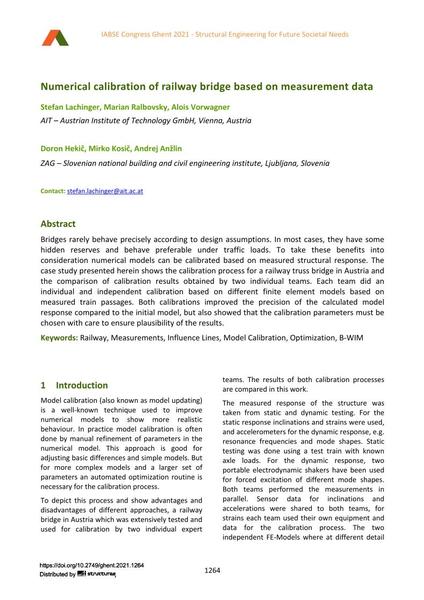Numerical calibration of railway bridge based on measurement data

|
|
|||||||||||
Bibliographic Details
| Author(s): |
Stefan Lachinger
(AIT – Austrian Institute of Technology GmbH, Vienna, Austria)
Marian Ralbovsky (AIT – Austrian Institute of Technology GmbH, Vienna, Austria) Alois Vorwagner (AIT – Austrian Institute of Technology GmbH, Vienna, Austria) Doron Hekič (ZAG – Slovenian national building and civil engineering institute, Ljubljana, Slovenia) Mirko Kosič (ZAG – Slovenian national building and civil engineering institute, Ljubljana, Slovenia) Andrej Anžlin (ZAG – Slovenian national building and civil engineering institute, Ljubljana, Slovenia) |
||||
|---|---|---|---|---|---|
| Medium: | conference paper | ||||
| Language(s): | English | ||||
| Conference: | IABSE Congress: Structural Engineering for Future Societal Needs, Ghent, Belgium, 22-24 September 2021 | ||||
| Published in: | IABSE Congress Ghent 2021 | ||||
|
|||||
| Page(s): | 1264-1272 | ||||
| Total no. of pages: | 9 | ||||
| DOI: | 10.2749/ghent.2021.1264 | ||||
| Abstract: |
Bridges rarely behave precisely according to design assumptions. In most cases, they have some hidden reserves and behave preferable under traffic loads. To take these benefits into consideration numerical models can be calibrated based on measured structural response. The case study presented herein shows the calibration process for a railway truss bridge in Austria and the comparison of calibration results obtained by two individual teams. Each team did an individual and independent calibration based on different finite element models based on measured train passages. Both calibrations improved the precision of the calculated model response compared to the initial model, but also showed that the calibration parameters must be chosen with care to ensure plausibility of the results. |
||||
| Keywords: |
optimization railroad measurements B-WIM model calibration Influence Lines
|
||||
| Copyright: | © 2021 International Association for Bridge and Structural Engineering (IABSE) | ||||
| License: | This creative work is copyrighted material and may not be used without explicit approval by the author and/or copyright owner. |
||||
